LAWS20058 Australian Commercial Law: Application of Legal Framework
VerifiedAdded on 2023/06/10
|12
|3260
|145
Case Study
AI Summary
This assignment provides a comprehensive analysis of Australian Commercial Law, incorporating legal theories and case studies. It begins by examining H.L.A. Hart's three-tier legal system and its applicability. The assignment then compares the criminal law systems of New Zealand and Australia, highlighting the influence of British legal rules. Furthermore, it delves into contract law through the analysis of Gumland Property case, focusing on lease agreements and termination conditions, referencing key cases like Shevill v Builders Licensing Board and Progressive Mailing House Pty Ltd v Tabali Pty Ltd. Lastly, the assignment addresses fraudulent misrepresentation in the context of Alati v Kruger, examining the elements required to establish misrepresentation and the remedies available under Australian Consumer Law. The document concludes that in the presence of valid misrepresentation factors, the affected party can revoke the contract and claim compensation.
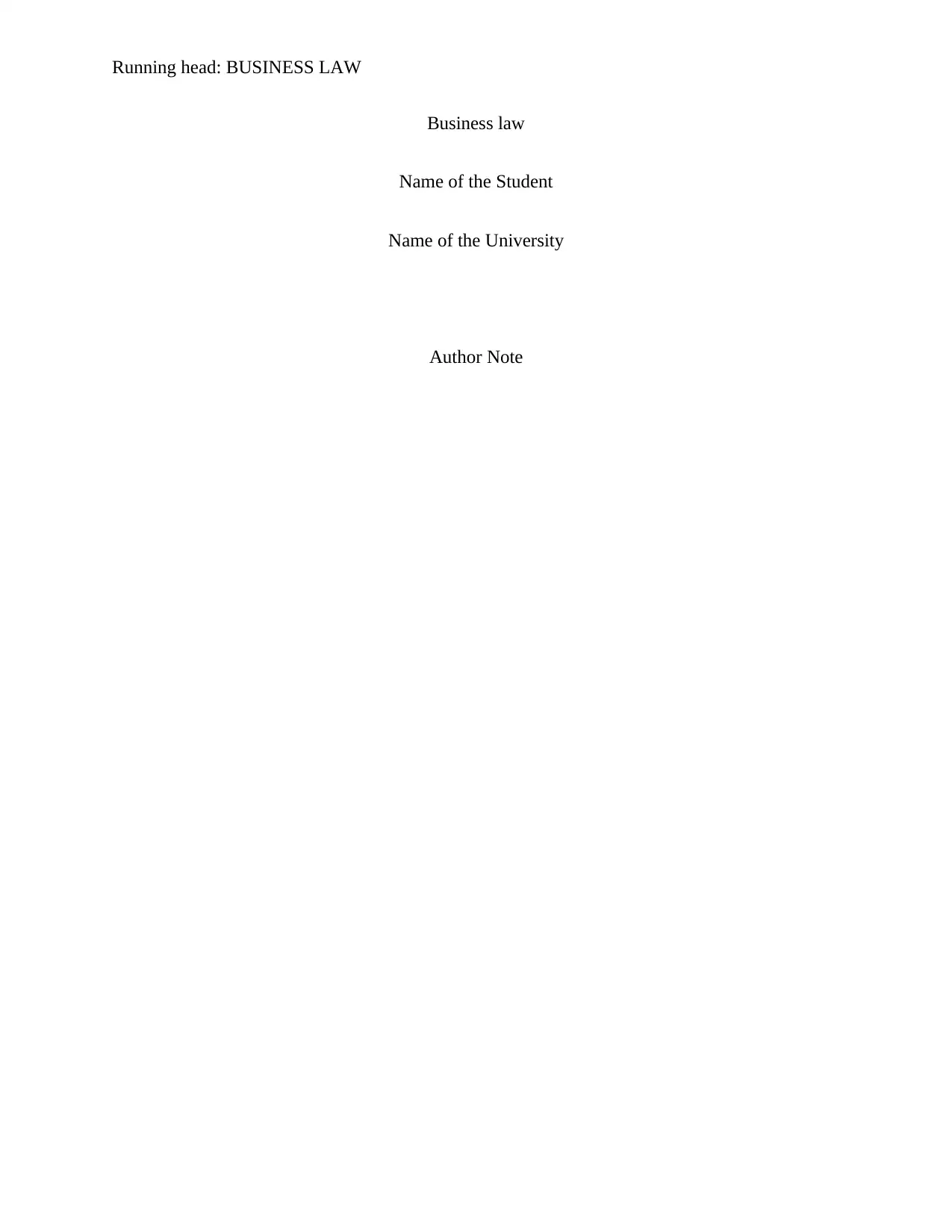
Running head: BUSINESS LAW
Business law
Name of the Student
Name of the University
Author Note
Business law
Name of the Student
Name of the University
Author Note
Paraphrase This Document
Need a fresh take? Get an instant paraphrase of this document with our AI Paraphraser

1BUSINESS LAW
Part A
H.L.A Hart, a famous philosopher of British origin has created a theory based upon a
three-tier legal system which is prevalent. The theory defines the process by which formation of
legal rules can be into law. “Concept of law”, is a book written by Hart himself speaks about
particular regulations on the acknowledgment, changes and mediation1. In order to make laws
there should be some uniform strategies and rules which shall be recognized as essential
elements to be approved. The rules should be such that it can be changed whenever required to
suit the societal needs. However, there shall also be a body that will look after the other bodies
that does not go behind the standard principles and will stop from breaking the rules of the
society by adjudicating on it.
Hart said that there should be a uniform constitution or a codified framework which shall
be a uniform code for adjudicating. However, the society shall have to abide by the rules and
regulations so that justice prevails in the society. The doctrine of separation of power is a very
important tool to govern the society without any biases. As we know society is governed by
customs, therefore the law should be made accepting all the customs. The legal framework
should be flexible so that it can adjust and fit the changing needs of the society. Lastly, there
should be a judiciary which will adjudicate the legal principles for the society. Thus, in this
manner, the theory of Hart can be implemented in the society2.
1 Hart, Herbert Lionel Adolphus. "Positivism and the Separation of Law and Morals." Law and Morality.
(Routledge, 2017). 63-99.
2 Raz, Joseph. "The rule of law and its virtue." The Rule of Law and the Separation of Powers. (Routledge, 2017).
77-94.
Part A
H.L.A Hart, a famous philosopher of British origin has created a theory based upon a
three-tier legal system which is prevalent. The theory defines the process by which formation of
legal rules can be into law. “Concept of law”, is a book written by Hart himself speaks about
particular regulations on the acknowledgment, changes and mediation1. In order to make laws
there should be some uniform strategies and rules which shall be recognized as essential
elements to be approved. The rules should be such that it can be changed whenever required to
suit the societal needs. However, there shall also be a body that will look after the other bodies
that does not go behind the standard principles and will stop from breaking the rules of the
society by adjudicating on it.
Hart said that there should be a uniform constitution or a codified framework which shall
be a uniform code for adjudicating. However, the society shall have to abide by the rules and
regulations so that justice prevails in the society. The doctrine of separation of power is a very
important tool to govern the society without any biases. As we know society is governed by
customs, therefore the law should be made accepting all the customs. The legal framework
should be flexible so that it can adjust and fit the changing needs of the society. Lastly, there
should be a judiciary which will adjudicate the legal principles for the society. Thus, in this
manner, the theory of Hart can be implemented in the society2.
1 Hart, Herbert Lionel Adolphus. "Positivism and the Separation of Law and Morals." Law and Morality.
(Routledge, 2017). 63-99.
2 Raz, Joseph. "The rule of law and its virtue." The Rule of Law and the Separation of Powers. (Routledge, 2017).
77-94.
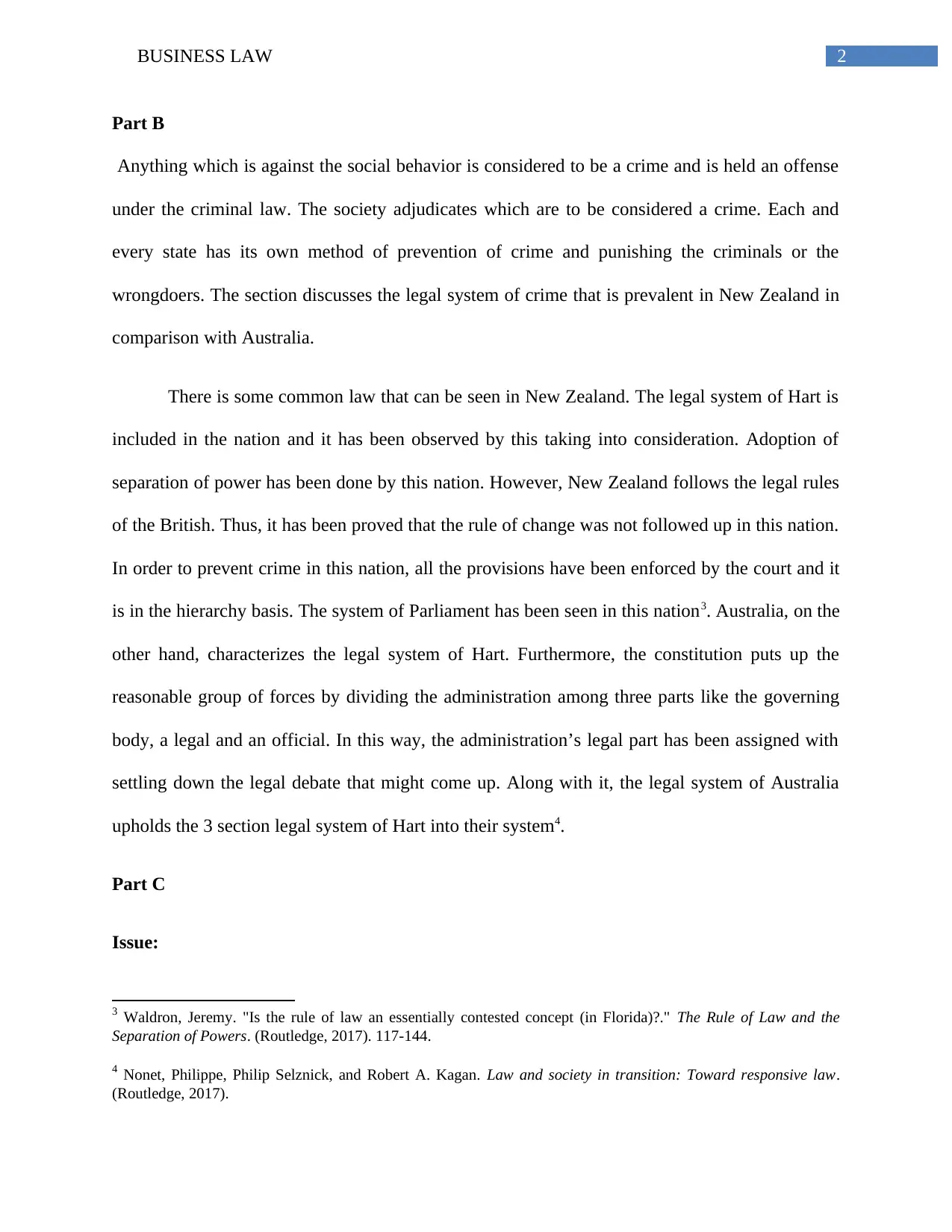
2BUSINESS LAW
Part B
Anything which is against the social behavior is considered to be a crime and is held an offense
under the criminal law. The society adjudicates which are to be considered a crime. Each and
every state has its own method of prevention of crime and punishing the criminals or the
wrongdoers. The section discusses the legal system of crime that is prevalent in New Zealand in
comparison with Australia.
There is some common law that can be seen in New Zealand. The legal system of Hart is
included in the nation and it has been observed by this taking into consideration. Adoption of
separation of power has been done by this nation. However, New Zealand follows the legal rules
of the British. Thus, it has been proved that the rule of change was not followed up in this nation.
In order to prevent crime in this nation, all the provisions have been enforced by the court and it
is in the hierarchy basis. The system of Parliament has been seen in this nation3. Australia, on the
other hand, characterizes the legal system of Hart. Furthermore, the constitution puts up the
reasonable group of forces by dividing the administration among three parts like the governing
body, a legal and an official. In this way, the administration’s legal part has been assigned with
settling down the legal debate that might come up. Along with it, the legal system of Australia
upholds the 3 section legal system of Hart into their system4.
Part C
Issue:
3 Waldron, Jeremy. "Is the rule of law an essentially contested concept (in Florida)?." The Rule of Law and the
Separation of Powers. (Routledge, 2017). 117-144.
4 Nonet, Philippe, Philip Selznick, and Robert A. Kagan. Law and society in transition: Toward responsive law.
(Routledge, 2017).
Part B
Anything which is against the social behavior is considered to be a crime and is held an offense
under the criminal law. The society adjudicates which are to be considered a crime. Each and
every state has its own method of prevention of crime and punishing the criminals or the
wrongdoers. The section discusses the legal system of crime that is prevalent in New Zealand in
comparison with Australia.
There is some common law that can be seen in New Zealand. The legal system of Hart is
included in the nation and it has been observed by this taking into consideration. Adoption of
separation of power has been done by this nation. However, New Zealand follows the legal rules
of the British. Thus, it has been proved that the rule of change was not followed up in this nation.
In order to prevent crime in this nation, all the provisions have been enforced by the court and it
is in the hierarchy basis. The system of Parliament has been seen in this nation3. Australia, on the
other hand, characterizes the legal system of Hart. Furthermore, the constitution puts up the
reasonable group of forces by dividing the administration among three parts like the governing
body, a legal and an official. In this way, the administration’s legal part has been assigned with
settling down the legal debate that might come up. Along with it, the legal system of Australia
upholds the 3 section legal system of Hart into their system4.
Part C
Issue:
3 Waldron, Jeremy. "Is the rule of law an essentially contested concept (in Florida)?." The Rule of Law and the
Separation of Powers. (Routledge, 2017). 117-144.
4 Nonet, Philippe, Philip Selznick, and Robert A. Kagan. Law and society in transition: Toward responsive law.
(Routledge, 2017).
⊘ This is a preview!⊘
Do you want full access?
Subscribe today to unlock all pages.

Trusted by 1+ million students worldwide
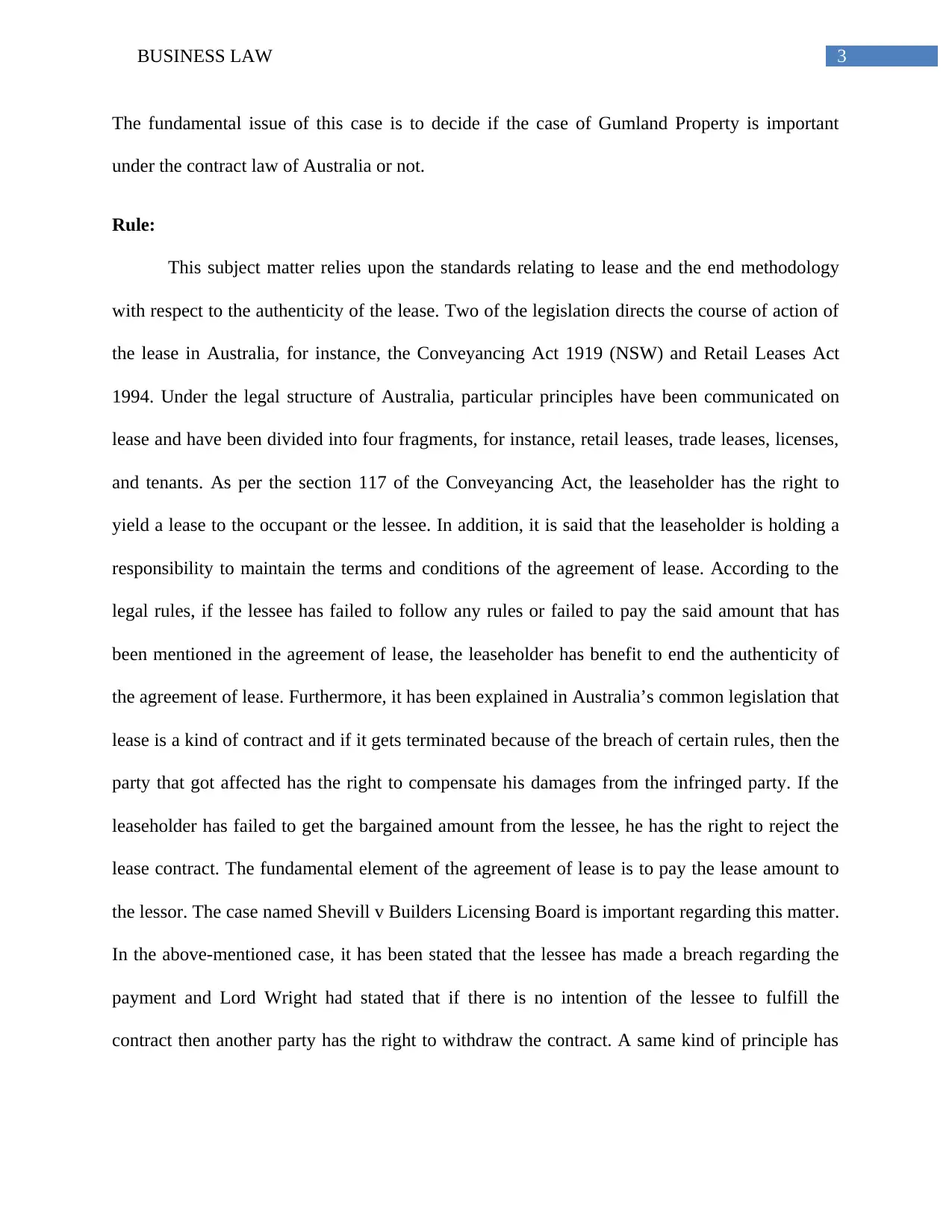
3BUSINESS LAW
The fundamental issue of this case is to decide if the case of Gumland Property is important
under the contract law of Australia or not.
Rule:
This subject matter relies upon the standards relating to lease and the end methodology
with respect to the authenticity of the lease. Two of the legislation directs the course of action of
the lease in Australia, for instance, the Conveyancing Act 1919 (NSW) and Retail Leases Act
1994. Under the legal structure of Australia, particular principles have been communicated on
lease and have been divided into four fragments, for instance, retail leases, trade leases, licenses,
and tenants. As per the section 117 of the Conveyancing Act, the leaseholder has the right to
yield a lease to the occupant or the lessee. In addition, it is said that the leaseholder is holding a
responsibility to maintain the terms and conditions of the agreement of lease. According to the
legal rules, if the lessee has failed to follow any rules or failed to pay the said amount that has
been mentioned in the agreement of lease, the leaseholder has benefit to end the authenticity of
the agreement of lease. Furthermore, it has been explained in Australia’s common legislation that
lease is a kind of contract and if it gets terminated because of the breach of certain rules, then the
party that got affected has the right to compensate his damages from the infringed party. If the
leaseholder has failed to get the bargained amount from the lessee, he has the right to reject the
lease contract. The fundamental element of the agreement of lease is to pay the lease amount to
the lessor. The case named Shevill v Builders Licensing Board is important regarding this matter.
In the above-mentioned case, it has been stated that the lessee has made a breach regarding the
payment and Lord Wright had stated that if there is no intention of the lessee to fulfill the
contract then another party has the right to withdraw the contract. A same kind of principle has
The fundamental issue of this case is to decide if the case of Gumland Property is important
under the contract law of Australia or not.
Rule:
This subject matter relies upon the standards relating to lease and the end methodology
with respect to the authenticity of the lease. Two of the legislation directs the course of action of
the lease in Australia, for instance, the Conveyancing Act 1919 (NSW) and Retail Leases Act
1994. Under the legal structure of Australia, particular principles have been communicated on
lease and have been divided into four fragments, for instance, retail leases, trade leases, licenses,
and tenants. As per the section 117 of the Conveyancing Act, the leaseholder has the right to
yield a lease to the occupant or the lessee. In addition, it is said that the leaseholder is holding a
responsibility to maintain the terms and conditions of the agreement of lease. According to the
legal rules, if the lessee has failed to follow any rules or failed to pay the said amount that has
been mentioned in the agreement of lease, the leaseholder has benefit to end the authenticity of
the agreement of lease. Furthermore, it has been explained in Australia’s common legislation that
lease is a kind of contract and if it gets terminated because of the breach of certain rules, then the
party that got affected has the right to compensate his damages from the infringed party. If the
leaseholder has failed to get the bargained amount from the lessee, he has the right to reject the
lease contract. The fundamental element of the agreement of lease is to pay the lease amount to
the lessor. The case named Shevill v Builders Licensing Board is important regarding this matter.
In the above-mentioned case, it has been stated that the lessee has made a breach regarding the
payment and Lord Wright had stated that if there is no intention of the lessee to fulfill the
contract then another party has the right to withdraw the contract. A same kind of principle has
Paraphrase This Document
Need a fresh take? Get an instant paraphrase of this document with our AI Paraphraser

4BUSINESS LAW
been mentioned in Federal Commerce v. Molena Alpha5. It has been seen in the case named
Progressive Mailing House Pty Ltd v Tabali Pty Ltd6 that in the agreement the amount that needs
to be paid is mentioned but the respondent failed to pay the amount. The court stated that the
payment of the lease is an important factor and if this factor is not followed then it would breach
the rule and the other party can rescind the contract.
Application
In the present situation, it has been noticed that there was a contract of lease agreement among
the parties. The rules of the agreement of lease state that a certain amount of lease has been given
by the lessor in this agreement and both these parties have agreed upon it. However, it was
noticed that one sublease as provided by the lessee and a certain amount of payment has been
fixed by the parties. In addition, it was also noticed that there was a reduction in the payable
amount because of some inconvenience. The agreement of the sublease expired in 2002 and
there was no interest of the sub-tenant to renew the agreement. In the same year, the lessee did
not pay the amount that was mentioned in the agreement and regarding this, a notice was
generated by the lessor. The lessee did not reply regarding this notice and a case was filed to
terminate this lease contract. If any person fails to pay the amount of lease then it is said to be
breaching the terms of the contract as per the rules of the Conveyancing Act 1919. In addition, it
can also be explained that the lease contract might be terminated if the lessee did not pay the
amount of lease.
Conclusion and Remedies
5 Federal Commerce Ltd v Molena Alpha Inc; (The 'Nanfri') CA ([1978] QB 927
6 Progressive Mailing House Pty Ltd v Tabali Pty Ltd - [1985] HCA 14
been mentioned in Federal Commerce v. Molena Alpha5. It has been seen in the case named
Progressive Mailing House Pty Ltd v Tabali Pty Ltd6 that in the agreement the amount that needs
to be paid is mentioned but the respondent failed to pay the amount. The court stated that the
payment of the lease is an important factor and if this factor is not followed then it would breach
the rule and the other party can rescind the contract.
Application
In the present situation, it has been noticed that there was a contract of lease agreement among
the parties. The rules of the agreement of lease state that a certain amount of lease has been given
by the lessor in this agreement and both these parties have agreed upon it. However, it was
noticed that one sublease as provided by the lessee and a certain amount of payment has been
fixed by the parties. In addition, it was also noticed that there was a reduction in the payable
amount because of some inconvenience. The agreement of the sublease expired in 2002 and
there was no interest of the sub-tenant to renew the agreement. In the same year, the lessee did
not pay the amount that was mentioned in the agreement and regarding this, a notice was
generated by the lessor. The lessee did not reply regarding this notice and a case was filed to
terminate this lease contract. If any person fails to pay the amount of lease then it is said to be
breaching the terms of the contract as per the rules of the Conveyancing Act 1919. In addition, it
can also be explained that the lease contract might be terminated if the lessee did not pay the
amount of lease.
Conclusion and Remedies
5 Federal Commerce Ltd v Molena Alpha Inc; (The 'Nanfri') CA ([1978] QB 927
6 Progressive Mailing House Pty Ltd v Tabali Pty Ltd - [1985] HCA 14

5BUSINESS LAW
Thus, it has been stated by the above situation that the lessor has the right to claim compensation.
This is because it was a breach of condition which had been agreed prior to the alternation of the
lease.
Part D
Case: Alati v Kruger 1955 HCA 64; ALR 1047
Issue
In the above-mentioned case, the issue is to establish any fraudulent misrepresentation that was
committed by respondent.
Rule
In order to claim for the misrepresentation legally, certain factors are required to be recognized.
The court stated in the case named Esso Petroleum v Mardon [1976] QB 8017 that there must be
an undue statement of the present fact and not of the future opinions to establish
misrepresentation.
The court declared in the case named Walters v Morgan (1861) 3 DF & J 7188 that no silence
will be taken as misrepresentation until and unless the agreement is of the good faith.
According to the case of Attwood v Small [1838] UKHL J609, in relation to the false statement
that was discussed above, there must be reliance to get in the contract to prove misrepresentation.
It has been said that an individual who is claiming for misrepresentation must prove the court
that he was influenced to get in the legal agreement with the other individual who made that false
7 Esso Petroleum v Mardon [1976] QB 801
8 Walters v Morgan (1861) 3 DF & J 718
9 Attwood v Small [1838] UKHL J60
Thus, it has been stated by the above situation that the lessor has the right to claim compensation.
This is because it was a breach of condition which had been agreed prior to the alternation of the
lease.
Part D
Case: Alati v Kruger 1955 HCA 64; ALR 1047
Issue
In the above-mentioned case, the issue is to establish any fraudulent misrepresentation that was
committed by respondent.
Rule
In order to claim for the misrepresentation legally, certain factors are required to be recognized.
The court stated in the case named Esso Petroleum v Mardon [1976] QB 8017 that there must be
an undue statement of the present fact and not of the future opinions to establish
misrepresentation.
The court declared in the case named Walters v Morgan (1861) 3 DF & J 7188 that no silence
will be taken as misrepresentation until and unless the agreement is of the good faith.
According to the case of Attwood v Small [1838] UKHL J609, in relation to the false statement
that was discussed above, there must be reliance to get in the contract to prove misrepresentation.
It has been said that an individual who is claiming for misrepresentation must prove the court
that he was influenced to get in the legal agreement with the other individual who made that false
7 Esso Petroleum v Mardon [1976] QB 801
8 Walters v Morgan (1861) 3 DF & J 718
9 Attwood v Small [1838] UKHL J60
⊘ This is a preview!⊘
Do you want full access?
Subscribe today to unlock all pages.

Trusted by 1+ million students worldwide
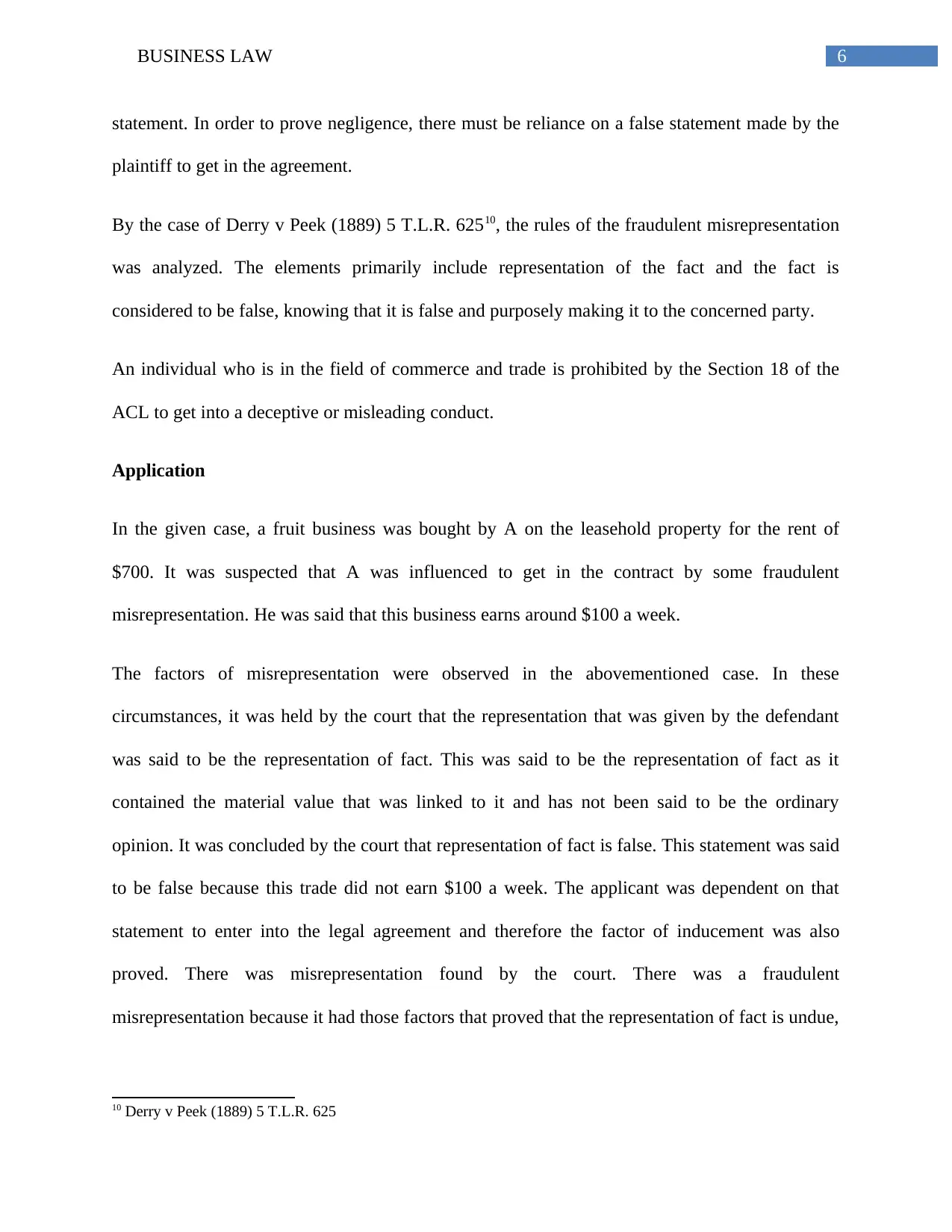
6BUSINESS LAW
statement. In order to prove negligence, there must be reliance on a false statement made by the
plaintiff to get in the agreement.
By the case of Derry v Peek (1889) 5 T.L.R. 62510, the rules of the fraudulent misrepresentation
was analyzed. The elements primarily include representation of the fact and the fact is
considered to be false, knowing that it is false and purposely making it to the concerned party.
An individual who is in the field of commerce and trade is prohibited by the Section 18 of the
ACL to get into a deceptive or misleading conduct.
Application
In the given case, a fruit business was bought by A on the leasehold property for the rent of
$700. It was suspected that A was influenced to get in the contract by some fraudulent
misrepresentation. He was said that this business earns around $100 a week.
The factors of misrepresentation were observed in the abovementioned case. In these
circumstances, it was held by the court that the representation that was given by the defendant
was said to be the representation of fact. This was said to be the representation of fact as it
contained the material value that was linked to it and has not been said to be the ordinary
opinion. It was concluded by the court that representation of fact is false. This statement was said
to be false because this trade did not earn $100 a week. The applicant was dependent on that
statement to enter into the legal agreement and therefore the factor of inducement was also
proved. There was misrepresentation found by the court. There was a fraudulent
misrepresentation because it had those factors that proved that the representation of fact is undue,
10 Derry v Peek (1889) 5 T.L.R. 625
statement. In order to prove negligence, there must be reliance on a false statement made by the
plaintiff to get in the agreement.
By the case of Derry v Peek (1889) 5 T.L.R. 62510, the rules of the fraudulent misrepresentation
was analyzed. The elements primarily include representation of the fact and the fact is
considered to be false, knowing that it is false and purposely making it to the concerned party.
An individual who is in the field of commerce and trade is prohibited by the Section 18 of the
ACL to get into a deceptive or misleading conduct.
Application
In the given case, a fruit business was bought by A on the leasehold property for the rent of
$700. It was suspected that A was influenced to get in the contract by some fraudulent
misrepresentation. He was said that this business earns around $100 a week.
The factors of misrepresentation were observed in the abovementioned case. In these
circumstances, it was held by the court that the representation that was given by the defendant
was said to be the representation of fact. This was said to be the representation of fact as it
contained the material value that was linked to it and has not been said to be the ordinary
opinion. It was concluded by the court that representation of fact is false. This statement was said
to be false because this trade did not earn $100 a week. The applicant was dependent on that
statement to enter into the legal agreement and therefore the factor of inducement was also
proved. There was misrepresentation found by the court. There was a fraudulent
misrepresentation because it had those factors that proved that the representation of fact is undue,
10 Derry v Peek (1889) 5 T.L.R. 625
Paraphrase This Document
Need a fresh take? Get an instant paraphrase of this document with our AI Paraphraser
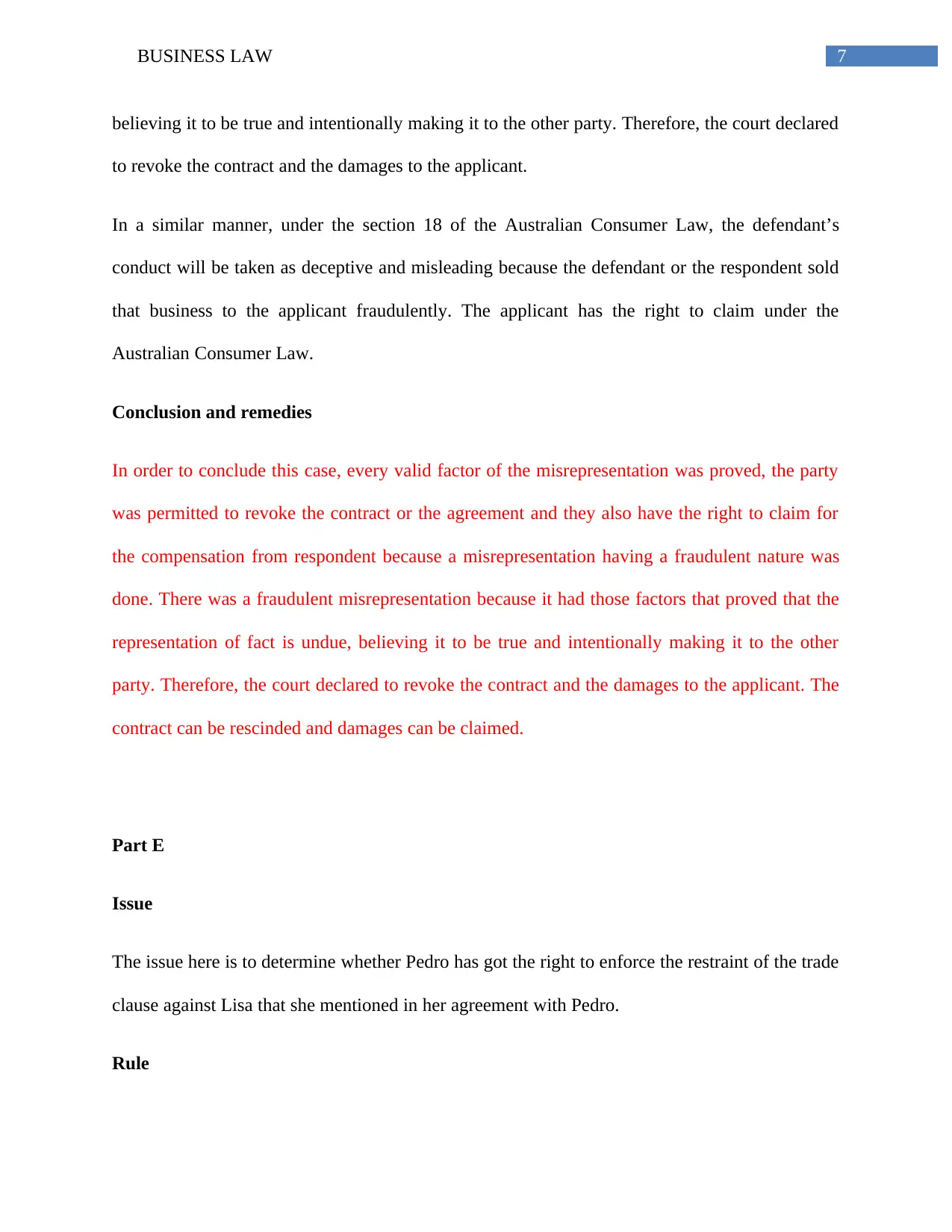
7BUSINESS LAW
believing it to be true and intentionally making it to the other party. Therefore, the court declared
to revoke the contract and the damages to the applicant.
In a similar manner, under the section 18 of the Australian Consumer Law, the defendant’s
conduct will be taken as deceptive and misleading because the defendant or the respondent sold
that business to the applicant fraudulently. The applicant has the right to claim under the
Australian Consumer Law.
Conclusion and remedies
In order to conclude this case, every valid factor of the misrepresentation was proved, the party
was permitted to revoke the contract or the agreement and they also have the right to claim for
the compensation from respondent because a misrepresentation having a fraudulent nature was
done. There was a fraudulent misrepresentation because it had those factors that proved that the
representation of fact is undue, believing it to be true and intentionally making it to the other
party. Therefore, the court declared to revoke the contract and the damages to the applicant. The
contract can be rescinded and damages can be claimed.
Part E
Issue
The issue here is to determine whether Pedro has got the right to enforce the restraint of the trade
clause against Lisa that she mentioned in her agreement with Pedro.
Rule
believing it to be true and intentionally making it to the other party. Therefore, the court declared
to revoke the contract and the damages to the applicant.
In a similar manner, under the section 18 of the Australian Consumer Law, the defendant’s
conduct will be taken as deceptive and misleading because the defendant or the respondent sold
that business to the applicant fraudulently. The applicant has the right to claim under the
Australian Consumer Law.
Conclusion and remedies
In order to conclude this case, every valid factor of the misrepresentation was proved, the party
was permitted to revoke the contract or the agreement and they also have the right to claim for
the compensation from respondent because a misrepresentation having a fraudulent nature was
done. There was a fraudulent misrepresentation because it had those factors that proved that the
representation of fact is undue, believing it to be true and intentionally making it to the other
party. Therefore, the court declared to revoke the contract and the damages to the applicant. The
contract can be rescinded and damages can be claimed.
Part E
Issue
The issue here is to determine whether Pedro has got the right to enforce the restraint of the trade
clause against Lisa that she mentioned in her agreement with Pedro.
Rule
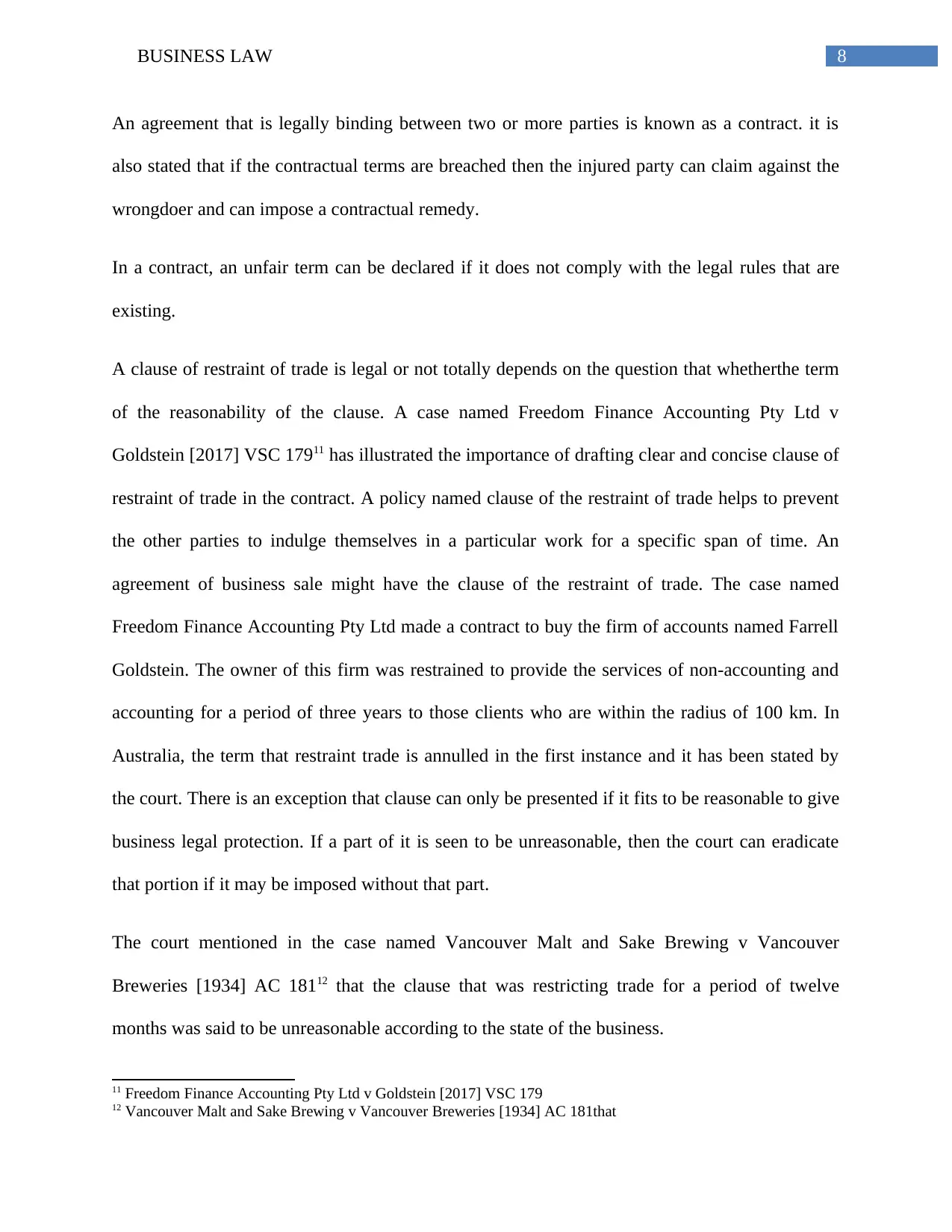
8BUSINESS LAW
An agreement that is legally binding between two or more parties is known as a contract. it is
also stated that if the contractual terms are breached then the injured party can claim against the
wrongdoer and can impose a contractual remedy.
In a contract, an unfair term can be declared if it does not comply with the legal rules that are
existing.
A clause of restraint of trade is legal or not totally depends on the question that whetherthe term
of the reasonability of the clause. A case named Freedom Finance Accounting Pty Ltd v
Goldstein [2017] VSC 17911 has illustrated the importance of drafting clear and concise clause of
restraint of trade in the contract. A policy named clause of the restraint of trade helps to prevent
the other parties to indulge themselves in a particular work for a specific span of time. An
agreement of business sale might have the clause of the restraint of trade. The case named
Freedom Finance Accounting Pty Ltd made a contract to buy the firm of accounts named Farrell
Goldstein. The owner of this firm was restrained to provide the services of non-accounting and
accounting for a period of three years to those clients who are within the radius of 100 km. In
Australia, the term that restraint trade is annulled in the first instance and it has been stated by
the court. There is an exception that clause can only be presented if it fits to be reasonable to give
business legal protection. If a part of it is seen to be unreasonable, then the court can eradicate
that portion if it may be imposed without that part.
The court mentioned in the case named Vancouver Malt and Sake Brewing v Vancouver
Breweries [1934] AC 18112 that the clause that was restricting trade for a period of twelve
months was said to be unreasonable according to the state of the business.
11 Freedom Finance Accounting Pty Ltd v Goldstein [2017] VSC 179
12 Vancouver Malt and Sake Brewing v Vancouver Breweries [1934] AC 181that
An agreement that is legally binding between two or more parties is known as a contract. it is
also stated that if the contractual terms are breached then the injured party can claim against the
wrongdoer and can impose a contractual remedy.
In a contract, an unfair term can be declared if it does not comply with the legal rules that are
existing.
A clause of restraint of trade is legal or not totally depends on the question that whetherthe term
of the reasonability of the clause. A case named Freedom Finance Accounting Pty Ltd v
Goldstein [2017] VSC 17911 has illustrated the importance of drafting clear and concise clause of
restraint of trade in the contract. A policy named clause of the restraint of trade helps to prevent
the other parties to indulge themselves in a particular work for a specific span of time. An
agreement of business sale might have the clause of the restraint of trade. The case named
Freedom Finance Accounting Pty Ltd made a contract to buy the firm of accounts named Farrell
Goldstein. The owner of this firm was restrained to provide the services of non-accounting and
accounting for a period of three years to those clients who are within the radius of 100 km. In
Australia, the term that restraint trade is annulled in the first instance and it has been stated by
the court. There is an exception that clause can only be presented if it fits to be reasonable to give
business legal protection. If a part of it is seen to be unreasonable, then the court can eradicate
that portion if it may be imposed without that part.
The court mentioned in the case named Vancouver Malt and Sake Brewing v Vancouver
Breweries [1934] AC 18112 that the clause that was restricting trade for a period of twelve
months was said to be unreasonable according to the state of the business.
11 Freedom Finance Accounting Pty Ltd v Goldstein [2017] VSC 179
12 Vancouver Malt and Sake Brewing v Vancouver Breweries [1934] AC 181that
⊘ This is a preview!⊘
Do you want full access?
Subscribe today to unlock all pages.

Trusted by 1+ million students worldwide
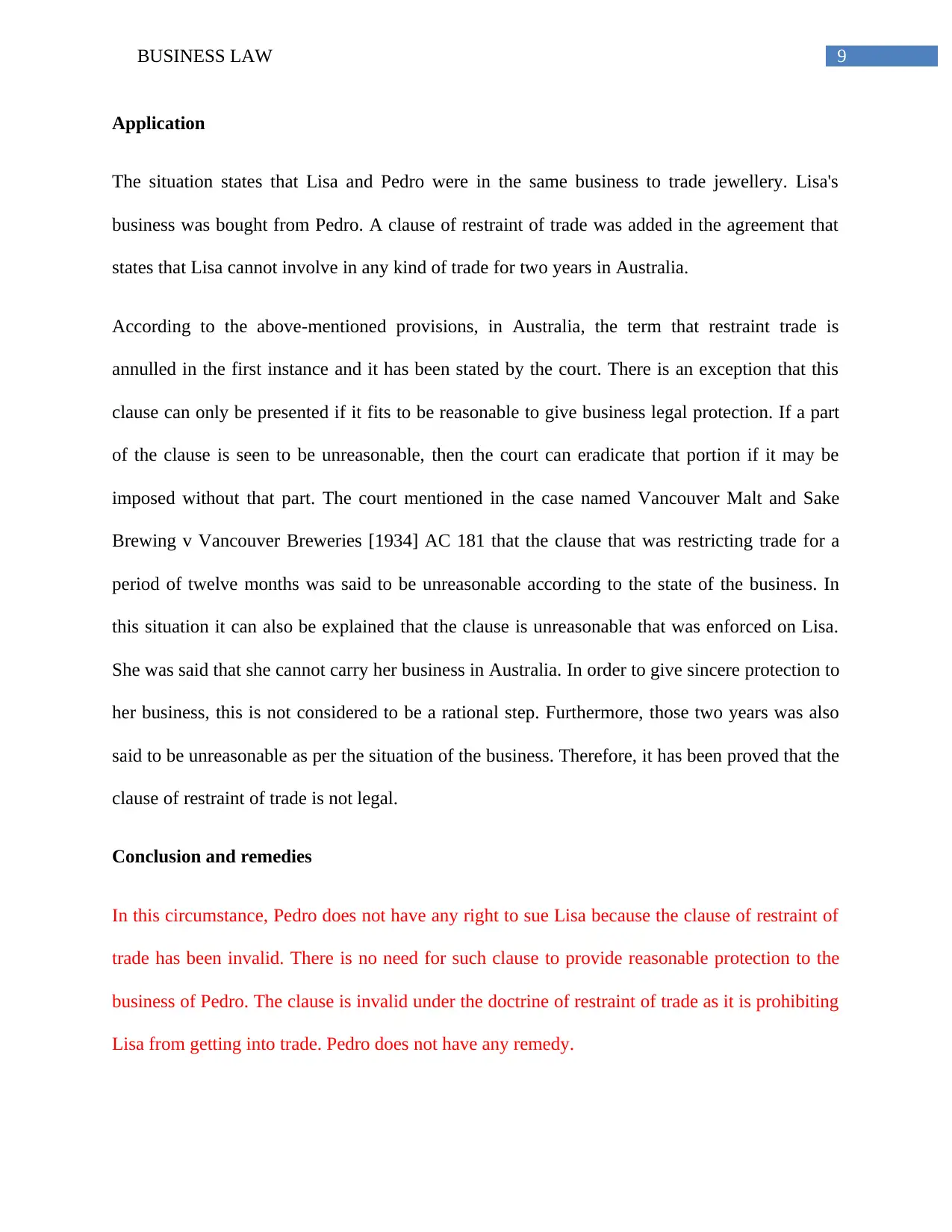
9BUSINESS LAW
Application
The situation states that Lisa and Pedro were in the same business to trade jewellery. Lisa's
business was bought from Pedro. A clause of restraint of trade was added in the agreement that
states that Lisa cannot involve in any kind of trade for two years in Australia.
According to the above-mentioned provisions, in Australia, the term that restraint trade is
annulled in the first instance and it has been stated by the court. There is an exception that this
clause can only be presented if it fits to be reasonable to give business legal protection. If a part
of the clause is seen to be unreasonable, then the court can eradicate that portion if it may be
imposed without that part. The court mentioned in the case named Vancouver Malt and Sake
Brewing v Vancouver Breweries [1934] AC 181 that the clause that was restricting trade for a
period of twelve months was said to be unreasonable according to the state of the business. In
this situation it can also be explained that the clause is unreasonable that was enforced on Lisa.
She was said that she cannot carry her business in Australia. In order to give sincere protection to
her business, this is not considered to be a rational step. Furthermore, those two years was also
said to be unreasonable as per the situation of the business. Therefore, it has been proved that the
clause of restraint of trade is not legal.
Conclusion and remedies
In this circumstance, Pedro does not have any right to sue Lisa because the clause of restraint of
trade has been invalid. There is no need for such clause to provide reasonable protection to the
business of Pedro. The clause is invalid under the doctrine of restraint of trade as it is prohibiting
Lisa from getting into trade. Pedro does not have any remedy.
Application
The situation states that Lisa and Pedro were in the same business to trade jewellery. Lisa's
business was bought from Pedro. A clause of restraint of trade was added in the agreement that
states that Lisa cannot involve in any kind of trade for two years in Australia.
According to the above-mentioned provisions, in Australia, the term that restraint trade is
annulled in the first instance and it has been stated by the court. There is an exception that this
clause can only be presented if it fits to be reasonable to give business legal protection. If a part
of the clause is seen to be unreasonable, then the court can eradicate that portion if it may be
imposed without that part. The court mentioned in the case named Vancouver Malt and Sake
Brewing v Vancouver Breweries [1934] AC 181 that the clause that was restricting trade for a
period of twelve months was said to be unreasonable according to the state of the business. In
this situation it can also be explained that the clause is unreasonable that was enforced on Lisa.
She was said that she cannot carry her business in Australia. In order to give sincere protection to
her business, this is not considered to be a rational step. Furthermore, those two years was also
said to be unreasonable as per the situation of the business. Therefore, it has been proved that the
clause of restraint of trade is not legal.
Conclusion and remedies
In this circumstance, Pedro does not have any right to sue Lisa because the clause of restraint of
trade has been invalid. There is no need for such clause to provide reasonable protection to the
business of Pedro. The clause is invalid under the doctrine of restraint of trade as it is prohibiting
Lisa from getting into trade. Pedro does not have any remedy.
Paraphrase This Document
Need a fresh take? Get an instant paraphrase of this document with our AI Paraphraser
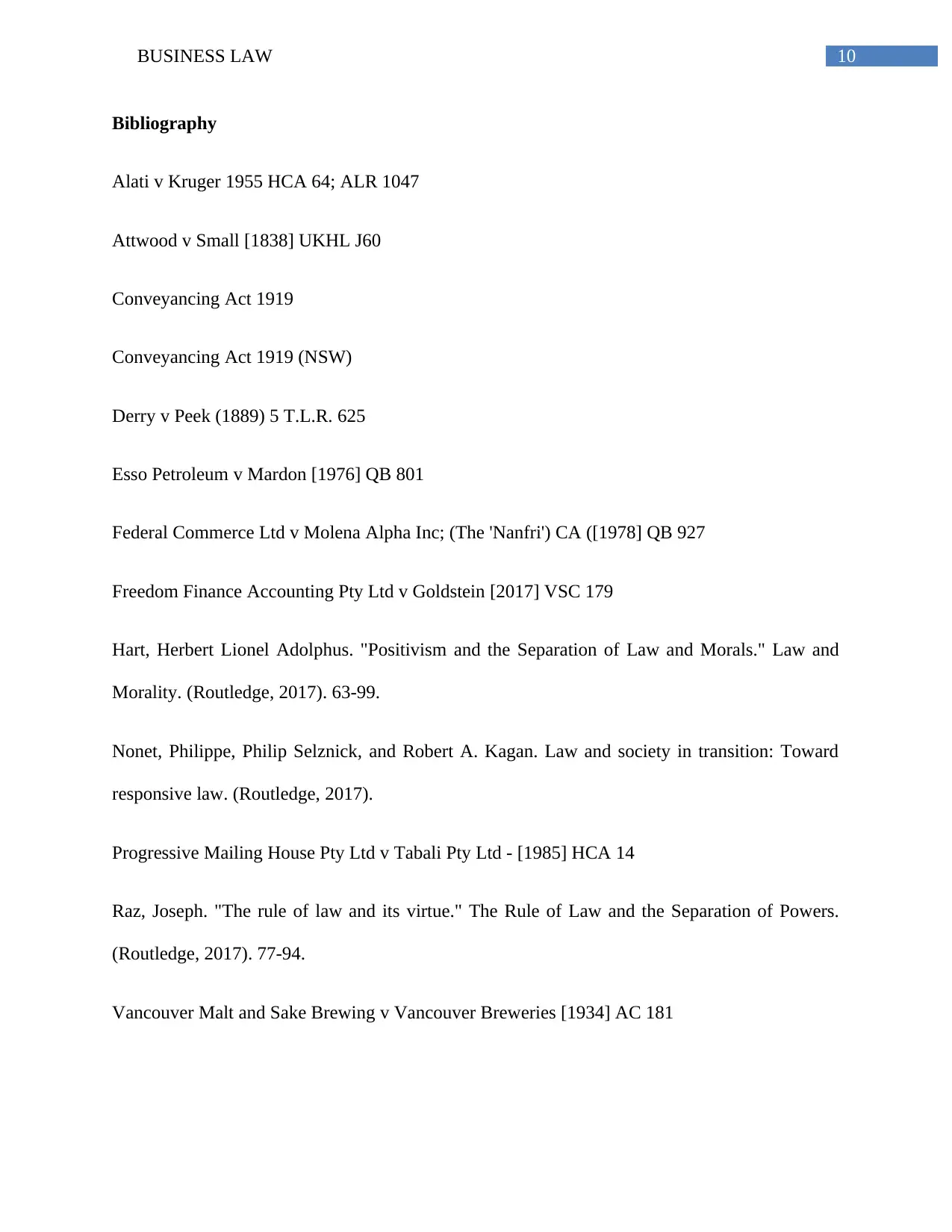
10BUSINESS LAW
Bibliography
Alati v Kruger 1955 HCA 64; ALR 1047
Attwood v Small [1838] UKHL J60
Conveyancing Act 1919
Conveyancing Act 1919 (NSW)
Derry v Peek (1889) 5 T.L.R. 625
Esso Petroleum v Mardon [1976] QB 801
Federal Commerce Ltd v Molena Alpha Inc; (The 'Nanfri') CA ([1978] QB 927
Freedom Finance Accounting Pty Ltd v Goldstein [2017] VSC 179
Hart, Herbert Lionel Adolphus. "Positivism and the Separation of Law and Morals." Law and
Morality. (Routledge, 2017). 63-99.
Nonet, Philippe, Philip Selznick, and Robert A. Kagan. Law and society in transition: Toward
responsive law. (Routledge, 2017).
Progressive Mailing House Pty Ltd v Tabali Pty Ltd - [1985] HCA 14
Raz, Joseph. "The rule of law and its virtue." The Rule of Law and the Separation of Powers.
(Routledge, 2017). 77-94.
Vancouver Malt and Sake Brewing v Vancouver Breweries [1934] AC 181
Bibliography
Alati v Kruger 1955 HCA 64; ALR 1047
Attwood v Small [1838] UKHL J60
Conveyancing Act 1919
Conveyancing Act 1919 (NSW)
Derry v Peek (1889) 5 T.L.R. 625
Esso Petroleum v Mardon [1976] QB 801
Federal Commerce Ltd v Molena Alpha Inc; (The 'Nanfri') CA ([1978] QB 927
Freedom Finance Accounting Pty Ltd v Goldstein [2017] VSC 179
Hart, Herbert Lionel Adolphus. "Positivism and the Separation of Law and Morals." Law and
Morality. (Routledge, 2017). 63-99.
Nonet, Philippe, Philip Selznick, and Robert A. Kagan. Law and society in transition: Toward
responsive law. (Routledge, 2017).
Progressive Mailing House Pty Ltd v Tabali Pty Ltd - [1985] HCA 14
Raz, Joseph. "The rule of law and its virtue." The Rule of Law and the Separation of Powers.
(Routledge, 2017). 77-94.
Vancouver Malt and Sake Brewing v Vancouver Breweries [1934] AC 181

11BUSINESS LAW
Waldron, Jeremy. "Is the rule of law an essentially contested concept (in Florida)?." The Rule of
Law and the Separation of Powers. (Routledge, 2017). 117-144.
Walters v Morgan (1861) 3 DF & J 718
Waldron, Jeremy. "Is the rule of law an essentially contested concept (in Florida)?." The Rule of
Law and the Separation of Powers. (Routledge, 2017). 117-144.
Walters v Morgan (1861) 3 DF & J 718
⊘ This is a preview!⊘
Do you want full access?
Subscribe today to unlock all pages.

Trusted by 1+ million students worldwide
1 out of 12
Related Documents
Your All-in-One AI-Powered Toolkit for Academic Success.
+13062052269
info@desklib.com
Available 24*7 on WhatsApp / Email
![[object Object]](/_next/static/media/star-bottom.7253800d.svg)
Unlock your academic potential
Copyright © 2020–2025 A2Z Services. All Rights Reserved. Developed and managed by ZUCOL.




